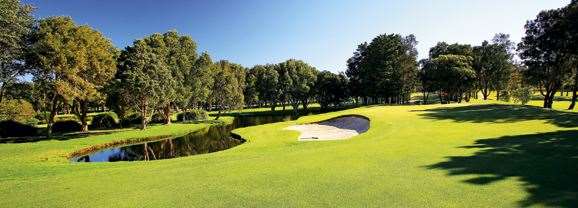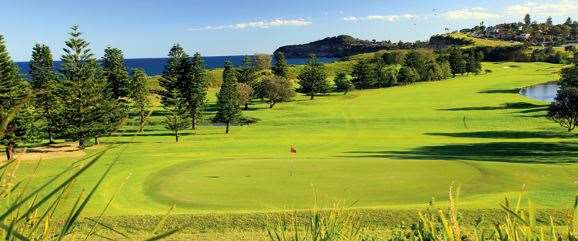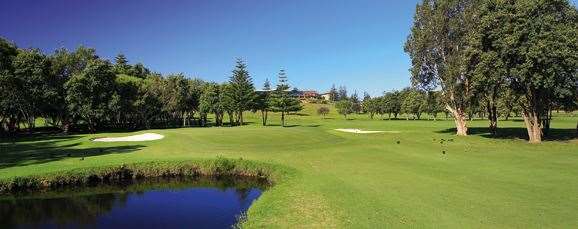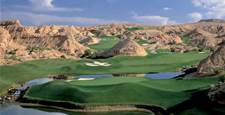Without sounding too much like a Quentin Tarantino film, any discussion about Mona Vale Golf Club needs to begin at the end.
Without sounding too much like a Quentin Tarantino film, any discussion about Mona Vale Golf Club needs to begin at the end.
The seaside layout on Sydney’s northern beaches has been popular with members and social players alike for decades, and part of the attraction for repeat visitors is to tackle the fearsome foursome that is the quartet of closing holes. No matter how promising a round you’ve put together through the first 14 holes, the crucible grows a little warmer once you stand on the 15th tee. Mona Vale’s picturesque oceanside holes are evident from the time you arrive but it takes you several hours of play before you reach this impressive crescendo. Pars from the 15th hole are hard to come by – even at the tiny 16th, which is exposed to the wind whichever direction it’s blowing from.
This home stretch begins with the course’s hardest hole, a 408-metre par-4 to an elevated green that often plays into the nor’ easterly wind. A large lake that sits between the 15th and 18th fairways will swallow any drive lost to the right of this gentle dogleg left and while the green is bunkerless, chipping and pitching close is a tough task due to the raised putting surface and obscured view. The 15th is a long, difficult par-4 where bogeys inflict little damage and birdies are rare.
The next is arguably Mona Vale’s finest hole. From a tee perched high above the green, the 133-metre 16th, with a long sloping green protected by three bunkers, can range from a modest flick with a wedge to a full-bore 4-iron if the southerly is howling up the coast. Because of the elevated tee, there is no protection from the elements so only pure strikes tend to find their target. The green is no picnic either, as three distinct sections – front left, centre and a shelf at the back – make two-putting from one portion to another difficult. This is an exquisite short hole where its apparent simplicity belies its true difficulty.
The two par-4s to close generally play as one downwind and one upwind excursion. A drive lost left off the 17th tee might miss dry land entirely as the fairway runs alongside a dune bordering the beach. From there the hole meanders towards a green with subtle movement and several hollows around it from where up-and-downs are not straightforward. The 18th is protected by water left of the fairway and a green armed with a false front that’s not necessarily detectable from fairway level. Many a promising score has been ruined by some overzealous chipping and putting on the last green.
As beautiful a location as Mona Vale Golf Club is, the club walked a rocky path before firmly establishing itself. Volunteer labour built the original nine holes and the clubhouse began life as a relocated ambulance station. The club had to negotiate with Warringah Council during the 1930s to lease land and a deal to acquire more land from the Salvation Army turned sour. Then, once World War II started, the government appropriated the course to establish a camp as the course’s clifftop location presented an ideal lookout from which to spot any sea-borne enemies. The impact of the defence forces saw the course take two full years to recover after the war. Later, in 1961, fire razed the clubhouse just one year after the course finally expanded to 18 holes.
Today, however, the course is a thriving hubbub of golfers and visitors to the club. While the design has remained largely unchanged for several years, gradual improvements to drainage, the playing surfaces and cosmetic elements of the course have elevated Mona Vale’s place among Sydney’s public courses. The fairways and greens are routinely superb and the work of award-winning course superintendent Andy Hugill proves that high traffic needn’t hamper overall conditioning. Granted, the course is flush with bore water – to the point that the club faces more issues dealing with any excess water than shortages.
However, with more than 60,000 played rounds in a typical year, there is minimal wear and tear evident across the course.
There is one couch fairway – the 12th – which was part of a drainage plan last decade that included thoughts of converting all the fairways from kikuyu to couch but was later abandoned. And quite rightly – the excellent kikuyu fairways are immaculate and maintained at an appropriate height, while also preserving length for a short-ish, 6,005-metre layout.
The golf course is mostly flat, save for a handful of tees atop the high ridge where the clubhouse sits, ensuring golfers return to the clubhouse precinct for several exhilarating downhill tee shots. One such drive kicks off the round, with the par-5 1st sending play onto the flat and through the groves of pines, gums and other established tall timber. The 2nd hole is home to one of the few design alterations to take place recently as a new bunker right of the green, which is shallower than it first appears thanks to its flashed-up face, is a welcome addition to the par-3 green complex.
The entire layout is susceptible to the seaside winds regardless of the various tree-lined pockets of the course you might be in. It’s a test suited to good wind players and straight hitters. Pods of sprawling Norfolk Island pines between some holes can create a ‘house of mirrors’ effect where there can appear to be no way out if you’re stuck in the middle of a bunch of trunks.
Three par-5s in the first five holes can kick-start a good score, although the last of this trio commands respect. The longest hole at Mona Vale at 505 metres, the 5th turns sharply left about 150 metres from the green. This twist means second shots need to be turned right-to-left to avoid running through the fairway but overdoing the shape can see balls find a lateral water hazard. Alternatively, a conservative lay-up will leave a long third short to a green cantered subtly right-to-left.
The 6th is a devious uphill 177-metre par-3 with a two-tiered green that rewards only those tee shots that fly all the way to the surface, before a tempting downhill par-4 at the 7th where water left of the green shouldn’t trouble approach shots but can rinse overly aggressive drives that leak to the left.
I’ve always liked the 9th hole, a 364-metre par-4 that plays straight into a nor’easter and is a tight drive even with no wind. A creek left is marked out-of-bounds, forcing a re-tee for anything lost in that direction, while the stand of trees lining the right side grows denser the further up the fairway you travel. A gentle right-to-left shot is ideal but must be shaped to perfection. The second shot is complicated by a multi-sectioned green, a couple of bunkers and the same creek running left of the putting surface and wrapping around the back.
The second nine begins with an uphill par-4 to return play to the clubhouse and on to an 11th hole that borders the 1st fairway and turns gently to the right just like the opener. Indeed, if there’s a criticism of the layout, it’s the three pairs of holes that are similar, such as the par-5s at 1 and 11, the uphill par-3s at 2 and 8, plus the long par-4s at 15 and 18. None of these six holes is bad but each one runs in the same direction, measures a similar distance and bears a striking resemblance to its lookalike.
The rest of back nine stems towards the far end of the course at the 13th tee before sending play towards the clubhouse. The 12th hole turns left then asks for a left-to-right approach to hold the side-sloping green where you don’t want to finish above the hole. The course’s final par-5 is next, starting from a sheltered teeing ground and widening to a fairway that slopes left but turns right. Drives risk running into the left trees so despite being a par-5, using less club from the tee is advisable. The green is pear-shaped with an extremely narrow front lobe that widens in the rear. Miss your approach to a front flag in the greenside bunker on the left (or worse, left of that) and the green won’t be the only thing that’s pear-shaped.
Offering one last legitimate birdie chance is the 134-metre 14th, a seemingly docile par-3 turning away from the sea. The long green is also narrow and well-bunkered, while the depth of the putting surface makes club selection difficult as a pitching wedge might be enough for a front hole location but a 6-iron could be required to find a rear cup position. Still, with an accurate strike a two is definitely on.
The 14th offers a final chance to breathe before tackling the closing quartet of holes that can make or break any round at Mona Vale.
THE COURSE
LOCATION: Golf Ave, Mona Vale. About 45 minutes’ drive north of the Sydney CBD via the Harbour Bridge, Military Rd and Pittwater Rd.
CONTACT: (02) 9999 4266. WEBSITE: www.mvgc.com.au.
DESIGNER: Club members (1960), Ross Watson (ongoing).
PLAYING SURFACES: Poa Annua (greens), kikuyu (fairways and rough), couch (tees).
COURSE SUPERINTENDENT: Andy Hugill.
PGA PROFESSIONAL: Gerard Kelly.
GREEN FEES: $35 Mondays and Tuesdays, $39 Wednesdays to Fridays, and $55 on weekends and public holidays.
Ten-hole rounds midweek cost $27, while two players sharing a cart pay $99 for 18 holes on Mondays and Tuesdays. Twilight rates allow unlimited holes after 3:30pm for $25 and $15 after 5:30pm in daylight savings time.
THE CLUB
MEMBERSHIPS: The club recently launched an all-inclusive $1,499 membership that features no joining fee and full playing rights. Other membership categories include five-day, “Fairway” and “Fairway Freshers” (which provide restricted access) as well as “Summertime” (which spans daylight savings time with an option to extend to the close of the subscription year). Visit the website for more details.
ACCOMMODATION: Reef Resort Apartments is walking distance from Mona Vale Golf Club and the beach and offers a selection of accommodation options for singles, couples or groups.
CORPORATE GOLF: Tuesdays and Fridays are the primary days for corporate events, with the club able to handle
every aspect of the event from welcome and warm-up to
on-course refreshments, setting up novelty prizes and scorecard collection.
FUNCTIONS: Mona Vale’s function rooms cater for 30 to 180 guests and the staff and facilities have seen it emerge as one of the area’s most popular wedding and function venues. It is also an ideal location for catered corporate training days, executive gatherings, conferences and birthday parties.
Related Articles

International Spotlight: Omanu Golf Club
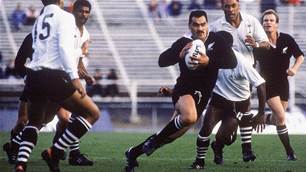
Celebrity Kiwi couple tee off in paradise



